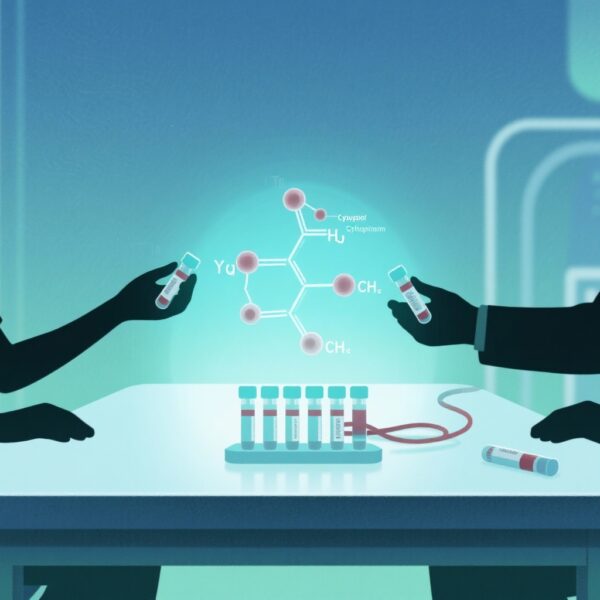Highlights
– In 988 consecutive unrelated donor HCTs using PTCy, isolated HLA‑DQB1 mismatch was not associated with worse overall survival, progression‑free survival, relapse, or non‑relapse mortality compared with 10/10 matched donors.
– A single HLA class I/II 7/8 mismatch increased the risk of grade III–IV acute GVHD but did not translate into higher NRM or shorter OS in this cohort.
– Increasing donor age was not associated with survival or relapse differences but correlated with a small increased risk of grade II–IV acute GVHD.
Background
Allogeneic hematopoietic cell transplantation (HCT) remains a potentially curative therapy for a range of hematologic malignancies, but optimal donor selection is critical to balance the graft‑versus‑leukemia effect against graft‑versus‑host disease (GVHD) and non‑relapse mortality (NRM). Historically, matching at HLA‑A, ‑B, ‑C, ‑DRB1 (8/8) and often HLA‑DQB1 has been recommended to reduce risks of graft failure and GVHD. With the growing adoption of high‑dose post‑transplant cyclophosphamide (PTCy) for GVHD prophylaxis — initially in haploidentical transplantation and subsequently extended to matched and mismatched unrelated donors — questions remain about whether PTCy attenuates the adverse effects historically associated with certain HLA mismatches and donor characteristics such as older age.
The clinical relevance of an isolated HLA‑DQB1 mismatch (with otherwise 8/8 match at A, B, C, DRB1) is incompletely defined, and donor age has variably been implicated as a contributor to GVHD risk and survival outcomes. The study by Mehta and colleagues (Transplant Cell Ther. 2025) provides contemporary, single‑center data evaluating these donor attributes in the context of unrelated donor HCT with uniform PTCy prophylaxis.
Study design
This single‑center retrospective cohort included 988 consecutive adults with hematologic malignancies undergoing a first unrelated donor HCT with PTCy‑based GVHD prophylaxis between 2017 and 2024. Patients were grouped by donor HLA matching as follows: 10/10 matched unrelated donors (MUD; n = 854), 8/8 MUD with an isolated HLA‑DQB1 mismatch (DQB1‑mismatch; n = 47), and 7/8 mismatched unrelated donors (7/8‑MMUD; n = 87). Donor age was analyzed as a continuous variable. Primary and secondary endpoints included overall survival (OS), progression‑free survival (PFS), non‑relapse mortality (NRM), relapse, and acute and chronic GVHD. Multivariable cause‑specific Cox proportional hazards models adjusted for relevant clinical covariates and competing risks.
Key findings
Overall survival and disease control
In adjusted analyses, neither an isolated HLA‑DQB1 mismatch nor a 7/8 mismatch was associated with inferior OS or PFS compared with 10/10 matched donors. For OS, the adjusted hazard ratios (HRs) were 0.84 (95% CI 0.48–1.48; P = .55) for the DQB1‑mismatch group and 1.10 (95% CI 0.75–1.61; P = .64) for the 7/8‑MMUD group versus 10/10 MUD. NRM and relapse risks were similarly not significantly different across groups: adjusted HRs for NRM were 0.92 (95% CI 0.45–1.89) for DQB1‑mismatch and 1.24 (95% CI 0.73–2.11) for 7/8‑MMUD (P = .69 overall); for relapse the HRs were 0.72 (95% CI 0.34–1.53) and 0.79 (95% CI 0.46–1.34), respectively (P = .46 overall).
GVHD outcomes
Chronic GVHD did not differ significantly between groups in multivariable models (P = .21), with point estimates suggesting no clear excess for DQB1 mismatch and a possible higher risk with 7/8‑MMUD (adjusted HR 1.53; 95% CI 0.85–2.76). Acute GVHD patterns diverged: 7/8‑MMUD recipients had a markedly increased risk of grade III–IV acute GVHD (adjusted HR 2.91; 95% CI 1.43–5.92; P = .003). The DQB1‑mismatch group showed a higher point estimate for grade II–IV acute GVHD (adjusted HR 1.63; 95% CI 0.98–2.71; P = .062) that did not reach conventional statistical significance, likely reflecting limited sample size in that subgroup.
Donor age
When handled as a continuous variable, donor age was not a significant predictor of OS, PFS, NRM, relapse, grade III–IV acute GVHD, or chronic GVHD. However, each additional year of donor age was associated with a modest increased hazard for grade II–IV acute GVHD (adjusted HR 1.02 per year; 95% CI 1.00–1.03; P = .011). This incremental effect suggests a small but measurable association between older donor age and moderate acute GVHD risk.
Interpretation and clinical implications
These results suggest that, in a contemporary cohort receiving PTCy prophylaxis, isolated HLA‑DQB1 mismatches do not materially worsen survival, relapse, or NRM compared with fully 10/10 matched unrelated donors. The lack of survival detriment despite a signal for increased grade II–IV aGVHD in the DQB1 mismatch group implies that PTCy may attenuate downstream mortality associated with some degrees of acute alloreactivity.
The finding that 7/8 mismatched donors confer an approximately threefold higher risk of severe (grade III–IV) acute GVHD is clinically important. However, in this cohort this did not translate into higher NRM or inferior OS, perhaps reflecting effective GVHD management under PTCy regimens, improvements in supportive care, or limited follow‑up/power to detect small survival differences. Practically, a 7/8 donor should still be considered higher risk, and transplant teams should weigh this against urgency of transplant, disease risk, and availability of alternative donors (e.g., matched unrelated, haploidentical, or cord blood).
Donor age showed only a small effect on moderate acute GVHD but no clear impact on survival or relapse. This aligns with a growing, yet nuanced, literature suggesting older donor age modestly increases GVHD risk but that the magnitude and clinical consequence depend on other variables (stem cell source, conditioning intensity, GVHD prophylaxis). Selection of a younger donor remains reasonable when other factors are equal, but older unrelated donors should not be automatically excluded in the PTCy era.
Biological plausibility and mechanistic considerations
PTCy is thought to preferentially deplete proliferating alloreactive T cells after transplantation while sparing regulatory T cells and promoting immune tolerance, thereby reducing the incidence and severity of GVHD across donor types. This immunomodulatory mechanism plausibly explains why previously observed adverse effects of certain HLA mismatches and donor characteristics might be mitigated under PTCy protocols. Nonetheless, some mismatches—particularly at loci that present highly immunogenic epitopes or when mismatches involve critical antigen‑binding residues—could still provoke clinically significant alloreactivity, as suggested by increased severe aGVHD in 7/8‑MMUD recipients.
Strengths and limitations
Strengths of the study include a large single‑center consecutive cohort treated with standardized PTCy prophylaxis, granular multivariable adjustment, and contemporary practice patterns. Limitations are inherent to retrospective, single‑center analyses: potential unmeasured confounding, center‑specific practices (conditioning regimens, supportive care, GVHD management) that limit generalizability, and limited power for subgroup analyses (notably the relatively small isolated DQB1‑mismatch group, n = 47). HLA typing resolution (allele vs antigen level), the exact locus mismatched at 7/8 donors, and the interplay with stem cell source or conditioning intensity were not fully delineated in the presented summary and could affect outcomes. Longer follow‑up may also be necessary to detect late differences in chronic GVHD and survival.
Expert commentary and guideline context
Current donor selection guidelines prioritize higher‑resolution HLA matching at A, B, C, DRB1 and often consider DQB1. However, clinical teams increasingly balance HLA matching with donor availability and urgency of transplant. The Mehta et al. data contribute timely, pragmatic evidence suggesting that, when PTCy is used, an isolated DQB1 mismatch may be acceptable and that older unrelated donors should not be categorically excluded. Nevertheless, guideline committees and transplantation centers should interpret these findings in the context of larger registry studies and randomized data when available. Multi‑center registry analyses (e.g., CIBMTR, EBMT) will be crucial to validate or refine donor selection algorithms in the PTCy era.
Practical recommendations
– Consider isolated HLA‑DQB1 mismatched unrelated donors as acceptable options when PTCy is employed, particularly if no 10/10 donor is readily available, but counsel recipients about a possible increase in moderate aGVHD risk and emphasize close monitoring.
– Treat 7/8 mismatches as higher risk for severe aGVHD; consider alternative donors where feasible and incorporate intensive GVHD surveillance and early intervention strategies if a 7/8 donor is used.
– Donor age may modestly increase the risk of grade II–IV aGVHD; prefer younger donors when multiple otherwise equivalent donors are available, but do not exclude older donors solely on age if other donor attributes are favorable.
Future research priorities
– Multicenter and registry‑based validation to confirm these findings across diverse practice settings and larger numbers of DQB1‑mismatched transplants.
– Detailed allele‑level HLA analyses to determine whether particular DQB1 alleles or mismatches at specific epitopes carry higher risk despite PTCy.
– Prospective studies or pooled analyses exploring interactions among donor age, stem cell source (bone marrow vs peripheral blood), conditioning intensity, and PTCy dosing/timing.
Conclusion
In this single‑center retrospective analysis of nearly 1,000 unrelated donor HCTs managed with PTCy, isolated HLA‑DQB1 mismatch and older donor age were not associated with worse survival, relapse, or NRM. A 7/8 mismatch increased risk of severe acute GVHD, and older donor age modestly raised the risk of grade II–IV aGVHD. These findings suggest that PTCy may mitigate some historical risks associated with certain donor characteristics; however, validation in larger, multi‑institutional cohorts and allele‑level analyses are needed before broad changes to donor selection policies are adopted.
Funding and clinicaltrials.gov
The original study (Mehta et al.) did not list funding details in the provided summary. For trial registration and funding details, please consult the published article: Mehta RS et al., Transplant Cell Ther. 2025;31(11):920.e1‑920.e14. doi: 10.1016/j.jtct.2025.08.011. PMID: 40819683.
References
1. Mehta RS, Aljawai YM, Kebriaei P, Olson A, Oran B, Rondon G, Rezvani K, Champlin RE, Shpall EJ. The Impact of Isolated HLA‑DQB1 Mismatch and Donor Age in Unrelated Donor Hematopoietic Cell Transplantation with Post‑Transplant Cyclophosphamide. Transplant Cell Ther. 2025 Nov;31(11):920.e1‑920.e14. doi: 10.1016/j.jtct.2025.08.011. Epub 2025 Aug 15. PMID: 40819683.
AI image prompt for article thumbnail
A clinical, realist image: a transplant physician in a modern clinic reviewing high‑resolution HLA typing results on a tablet, foreground shows labeled blood vials and a donor consent form; an overlay of a stylized DNA double helix and HLA allele names (A, B, C, DRB1, DQB1) fades into a teal‑navy background; soft, focused clinical lighting; photorealistic style.



